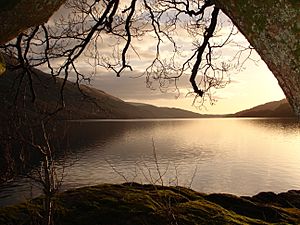The Bonnie Banks o' Loch Lomond facts for kids
"The Bonnie Banks o' Loch Lomond", or simply "Loch Lomond", is a very well-known Scottish folk song. It talks a lot about Loch Lomond, which is the largest lake (or "loch") in Scotland. This beautiful loch is located between the areas of West Dunbartonshire, Stirling, and Argyll and Bute. In the Scots language, "bonnie" means "attractive," "beloved," or "dear." The song tells a sad story, often thought to be about a soldier who will be executed and will return to Scotland only in spirit, while his love takes the "low road" (the path of the living).
Contents
Song Lyrics
Here are the words to the famous song:
By yon bonnie banks and by yon bonnie braes,
Where the sun shines bright on Loch Lomond,
Where me and my true love were ever wont to gae,
On the bonnie, bonnie banks o' Loch Lomond.
Chorus:
O ye'll tak' the high road, and I'll tak' the low road,
And I'll be in Scotland afore ye,
But me and my true love will never meet again,
On the bonnie, bonnie banks o' Loch Lomond.
'Twas there that we parted, in yon shady glen,
On the steep, steep side o' Ben Lomond,
Where in soft purple hue, the highland hills we view,
And the moon coming out in the gloaming.
Chorus
The wee birdies sing and the wildflowers spring,
And in sunshine the waters are sleeping.
But the broken heart it kens nae second spring again,
Though the waeful may cease frae their grieving.
Chorus
Other Versions of the Song
Irish Song Variant
There is an Irish version of this song called "Red Is the Rose." It uses the same tune but has different words. The Irish folk musician Tommy Makem made it very popular. Many people think he wrote it, but it is actually an old, traditional Irish folk song.
How the Song Has Been Used
"Loch Lomond" has been arranged and recorded by many different musicians. These recordings cover many music styles, from traditional Scottish folk to barbershop and even rock and roll.
Classical Music Versions
In 1921, Ralph Vaughan Williams created a special version for a baritone singer and a male choir without instruments. This version has been recorded several times. One famous recording was by the tenor Ian Partridge in 1970.
Popular Music Versions
The Scottish folk-rock band Runrig has made "Loch Lomond" their special song. They have ended their concerts with it for over 25 years. Parts of the song are now a favorite anthem for fans of the Scotland rugby team and the Tartan Army. The Tartan Army are the supporters of the Scotland football team. You can hear the song at their home games at Murrayfield Stadium in Edinburgh and Hampden Park in Glasgow.
In 2007, Runrig and the Tartan Army recorded a new version for BBC Children in Need. This version reached number nine on the UK Singles Chart and number one in Scotland. In 2022, this recording was recognized for selling and streaming over 200,000 copies. Scottish fans often sing this sad song loudly and quickly to cheer on their teams.
A Chinese singer-songwriter named Li Jian used the melody for a song with Mandarin words in his 2015 album. His song has a similar theme.
Jazz Music Versions
The Jazz Discography, which lists jazz recordings, shows many versions of "Loch Lomond." As of May 2019, it listed 106 recordings of "Loch Lomond" and one of "Bonnie Banks o' Loch Lomond."
A well-known big band version was arranged by Claude Thornhill. It was recorded live in 1938 by the Benny Goodman and His Orchestra. This recording was part of their famous album, The Famous 1938 Carnegie Hall Jazz Concert. It featured Martha Tilton singing.
Jazz singer Maxine Sullivan had a huge hit with "Loch Lomond." It became a very important song in her career. She recorded it at least 14 times. Her first recording was in 1937. Her last was a live performance in Tokyo in 1986, shortly before she passed away.
"Loch Lomond" in TV and Movies
The song has appeared in many films and TV shows:
- In Our Gang Follies of 1938, a short American musical film, Annabelle Logan (Annie Ross) sings "Loch Lomond" at a talent show.
- In the 1945 Sherlock Holmes film, Pursuit to Algiers, Dr. Watson (Nigel Bruce) sings the song. Sheila Woodbury (Marjorie Riordan) plays the piano.
- In the 1955 Disney animated movie Lady and the Tramp, a character named Jock, a Scottish terrier, sings his own version of the song.
- The song is heard in the 1963 Disney film The Three Lives of Thomasina.
- A recording of a Scotsman singing the song during the First World War was shown in the 2007 BBC documentary How the Edwardians Spoke.
- In the children's cartoon Animaniacs, the song is heard in the episode "Ups and Downs." It is also in the Animaniacs movie Wakko's Wish.
- In the 2021 film A Castle for Christmas, the cast sings it during a pub scene.
- In the American TV show The Simpsons, Groundskeeper Willie whistles the tune in the episode "Lard of the Dance".
- In the Hal Roach short comedy film Tit for Tat, Stan Laurel sings a part of the song. This happens after Oliver Hardy says he will take the "high road" during an argument.
- In Smallville Season 7 Episode 19, the tune is played by a grandfather clock and later by Lex Luthor on the piano.


